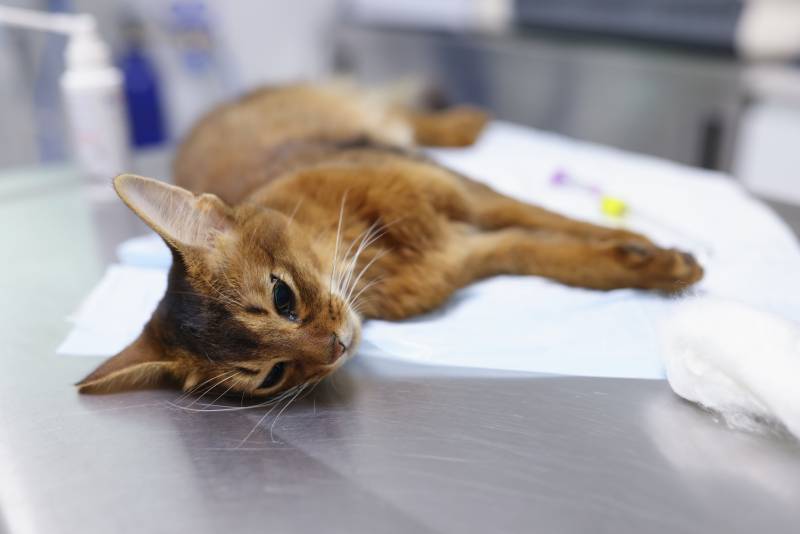Curious cats can cajole their way into anything, and when they catch sight of your savory steak dinner, they’ll do everything they can to snag a taste. Fortunately for them, there’s little reason to say “No”. Although it may not take up much of their standard diet, cats can eat steak and benefit considerably from it.
As an obligate carnivore, your cat primarily eats meat to get the protein and healthy fats that fuel their bodies. While steak can fit into their daily diet, a few essential considerations can help guide your decision to serve it. Let’s discuss if cats can eat steak and the various benefits and drawbacks of serving it to your pet.
Can Cats Eat Steak?
Steak is a healthy food for a cat. It contains high amounts of animal protein, the cat’s primary energy source that provides macronutrients to build muscle. A high-protein diet is even more critical for cats because while they need the nine essential amino acids in their diet like all mammals, they also can’t synthesize taurine or arginine. Taurine aids reproduction, kitten development, and heart and eye health, while arginine manages the body’s ammonia levels.
Alongside the generous protein levels, steak provides valuable vitamins and minerals for cats, including:
Accounting for roughly 20%-24% of a cat’s daily nutrition, fats are the most vital component of your pet’s diet after protein. Steak is a decent source of cat-friendly fats, providing energy and linoleic acid for immune support and a healthy coat.

How Much Steak Can I Feed My Cat?
You can offer steak to your cat as a treat occasionally. Despite its benefits, steak should only be one of many components in any dietary plan because it doesn’t adequately address all your cat’s nutritional needs, such as fiber and calcium.
It’s also dense, emphasizing the need to watch how much you give your cat. Cats only need around 20-30 calories per pound of body weight daily. Since one ounce of steak contains 77 calories, it won’t take much to reach their limit in red meat alone.
Cats will only maximize steak’s benefits if it’s part of a complete, balanced diet. Talk with your vet about formulating a plan before beginning a homemade cat diet that includes beef products like steak.
You can feed steak snacks without worrying about balancing it with other foods. Standard cat food will provide all the nutrients your pet needs to stay healthy. As a treat, steak shouldn’t account for more than 10% of your cat’s daily caloric intake.
Drawbacks to Feeding Your Cat Steak
Too much steak can adversely affect your cat’s gastrointestinal system, particularly if it has a high-fat content. Your cat may experience nausea or diarrhea, and in the long term, they’ll be more susceptible to obesity and related heart problems. Meanwhile, less protein in the diet may be necessary for cats with chronic kidney or liver diseases, forcing you to cut the meaty treats out of their diet entirely.

How Should I Feed My Cat Steak?
The safest way to feed steak to your cat is well-cooked and plain without any seasonings. Some ingredients, like onion, garlic, and other alliums, are toxic to cats, potentially causing hemolytic anemia.
The steak should be lean and trimmed of excess fat. While some fat is necessary, they’ll receive enough in the meaty portions, and the extra trimmings can easily cause an upset stomach. The steak should be bone-free to avoid tooth damage, choking, bowel obstructions, or splintered pieces that could cause damage along the GI tract.
Can I Feed My Cat Raw Steak?
Raw meat-based diets (RMBDs) are becoming more popular with pet owners seeking to replicate their pets’ ancestral diet. Many commercial products are now available in freeze-dried, frozen, and fresh forms, though some pet owners craft their meals at home.
While there’s little scientific evidence of the advantage of RMBDs versus standard diets, many owners offer anecdotal support for their practicality. Coat and skin benefits, behavioral improvements, higher stool quality, and reduced dental disease are common arguments for raw meat, and many feel their cats find it tastier than cooked foods.
Raw steak’s issue is that it can expose your cat to hazardous bacteria and parasites, including Toxoplasma gondii, salmonella, listeria, and E. coli. Though not all suffer signs of illness, some cats experience GI issues and other assorted health problems. Once they consume these pathogens, cats can shed and spread them in feces, potentially putting the household at risk.
The AAFCO warns of the inherent risks in raw meat diets, while the AVMA discourages feeding meat without appropriate processing. Avoiding raw meat may be necessary for older and ailing cats or if you have at-risk children or adults in the home.

Final Thoughts
Every pet parent wants to make the best food choices for their cats, and steak is one treat they can feel good about serving. Cats love the taste and enjoy many benefits when it’s part of a high-quality, balanced diet.
It’s vital to implement cautious handling practices and cook the steak thoroughly to avoid disease. If you’re interested in making beef a mainstay in your cat’s diet, talk to your vet about effectively incorporating this savory and satisfying food into a healthy meal plan.

